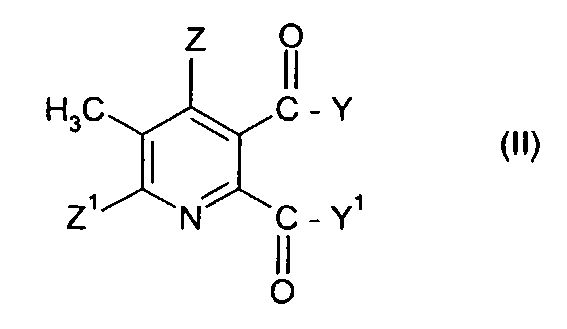FIELD: chemistry.
SUBSTANCE: invention refers to a method for producing 5,6-disubstituted 3-pyridylmethyl ammonium bromides  , wherein Q represents a tertiary aliphatic or cyclic, saturated, partially unsaturated or aromatic amine; Z represents hydrogen or halogen; Z1 represents hydrogen, halogen cyano or nitro; each Y and Y1 independently represents OR1, NR1R2, or wherein YY1 together represent -O-, -S- or NR3-; each R1 and R2 independently represents hydrogen, C1-C4 alkyl optionally substituted by C1-C4 alkoxy or phenyl optionally substituted by one-three C1-C4 alkyl groups, C1-C4 alkoxy groups or halogen atoms, or a phenyl optionally substituted by one-three C1-C4 alkyl groups, C1-C4 alkoxy groups or halogen atoms; R3 represents hydrogen or C1-C4 alkyl, which involves the stages of (i) interaction of a compound of formula
, wherein Q represents a tertiary aliphatic or cyclic, saturated, partially unsaturated or aromatic amine; Z represents hydrogen or halogen; Z1 represents hydrogen, halogen cyano or nitro; each Y and Y1 independently represents OR1, NR1R2, or wherein YY1 together represent -O-, -S- or NR3-; each R1 and R2 independently represents hydrogen, C1-C4 alkyl optionally substituted by C1-C4 alkoxy or phenyl optionally substituted by one-three C1-C4 alkyl groups, C1-C4 alkoxy groups or halogen atoms, or a phenyl optionally substituted by one-three C1-C4 alkyl groups, C1-C4 alkoxy groups or halogen atoms; R3 represents hydrogen or C1-C4 alkyl, which involves the stages of (i) interaction of a compound of formula  , wherein the symbols have values specified for formula (I) with bromine in the presence a radical initiator in the mixture of solvents containing an aqueous phase and an organic phase, wherein the organic phase contains a solvent specified in 1,2-dichloroethane, chlorobenzene, 1,2-dichlorobenzene, 1,3-dichlorobenzene, 1,4-dichlorobenzene and tetrachloromethane, and wherein pH of the aqueous phase makes from 3 to <8 to produce 3-bromomethyl-5,6-disubstituted pyridine compound
, wherein the symbols have values specified for formula (I) with bromine in the presence a radical initiator in the mixture of solvents containing an aqueous phase and an organic phase, wherein the organic phase contains a solvent specified in 1,2-dichloroethane, chlorobenzene, 1,2-dichlorobenzene, 1,3-dichlorobenzene, 1,4-dichlorobenzene and tetrachloromethane, and wherein pH of the aqueous phase makes from 3 to <8 to produce 3-bromomethyl-5,6-disubstituted pyridine compound  , wherein Y, Y1, Z and Z1 have values specified for formula (I), and (ii) interaction of the bromine compound of formula (III) with tertiary amine base Q in the solvent at a temperature falling within the range of 0°C to 100°C.
, wherein Y, Y1, Z and Z1 have values specified for formula (I), and (ii) interaction of the bromine compound of formula (III) with tertiary amine base Q in the solvent at a temperature falling within the range of 0°C to 100°C.
EFFECT: higher effectiveness of the method.
14 cl, 7 ex
Authors
Dates
2015-05-10—Published
2009-11-13—Filed